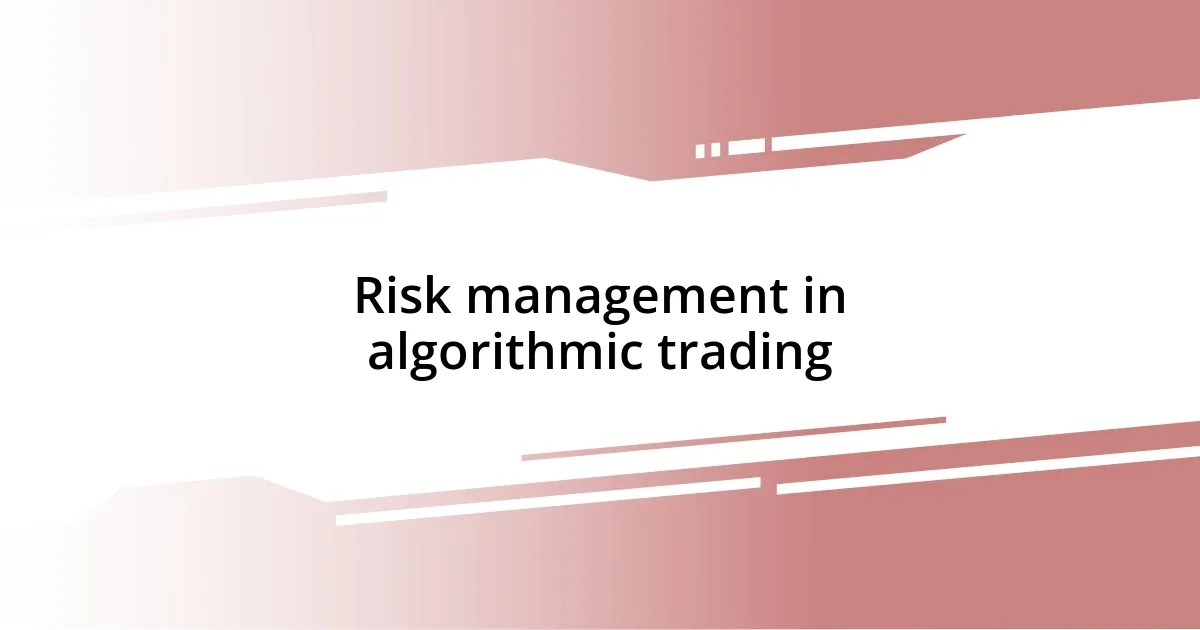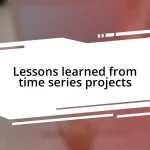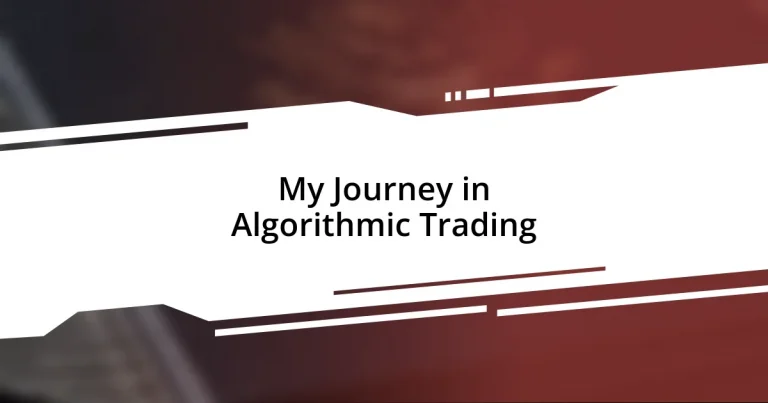Key takeaways:
- Discovered the potential of algorithmic trading through coding and backtesting, leading to a deeper understanding of market mechanics.
- Emphasized the significance of risk management, using strategies like stop-loss orders and position sizing to protect capital.
- Learned that patience and collaboration with other traders significantly enhance trading strategies and outcomes.

My introduction to algorithmic trading
It all started when I stumbled upon a forum discussing algorithmic trading. I was fascinated by the idea of using code to make trading decisions. Could it really be possible to leverage technology in a way that could outperform human intuition? I couldn’t shake the curiosity, so I dove deeper.
As I explored the world of algorithms, I remember feeling a blend of excitement and apprehension. The complexity of coding seemed daunting at first. But I was determined to learn; the potential rewards were too enticing to ignore. I took my first steps into programming, starting with Python, and each small victory filled me with confidence.
Eventually, I began to see the connections between my newfound skills and the market’s movements. The thrill of backtesting my strategies was addictive—I could spend hours fine-tuning an algorithm to achieve that elusive edge. Did I expect to hit it big right away? Of course not, but the journey of learning and discovery fueled my passion even more.

Understanding algorithmic trading basics
Understanding algorithmic trading begins with grasping the key concepts that drive it. At its core, algorithmic trading involves automated processes to execute trades based on pre-defined criteria. I still recall my excitement when I first realized that algorithms could analyze market data at lightning speed, much faster than I could ever do manually. It was eye-opening to think about how this technology could optimize trading strategies and significantly enhance decision-making.
The beauty of algorithmic trading lies in its ability to remove emotional biases from the trading process. In my early experiences, I often found myself reacting to market fluctuations with anxiety or overconfidence. Once I started to rely on algorithms, I experienced a newfound sense of calm. The strategies I developed were based on data and statistics, allowing me to step back and trade more thoughtfully, rather than impulsively.
A crucial aspect of understanding these basics is recognizing the different types of algorithms and their purposes. For instance, some algorithms are designed for high-frequency trading, which entails making numerous trades within seconds to capitalize on small price discrepancies. Others focus on trend-following strategies, where the goal is to identify and act on market trends over longer periods. It’s compelling to reflect on how each type served a different purpose in my journey, allowing me to explore various trading styles and approaches.
| Aspect | Description |
|---|---|
| Definition | Use of automated systems to execute trades based on specific rules. |
| Benefits | Reduces emotional trading, enhances speed and efficiency, and improves strategy execution. |
| Common Types | High-frequency trading, trend-following strategies, arbitrage algorithms, market-making. |

Building my first trading algorithm
Building my first trading algorithm was a mixture of exhilaration and uncertainty. I distinctly remember the late nights spent poring over tutorials, trying to grasp the syntax of Python while simultaneously straddling the complexities of market indicators. It was during those long hours that the thrill of actually seeing my code perform live trades felt like magic—like I was conjuring something real out of lines of text. Each small success was a step forward, affirming that I was on the right track.
- I started by identifying a simple strategy: using moving averages to signal potential buy and sell points.
- I utilized online resources to research coding basics, focusing specifically on functions that could handle market data and trades.
- Backtesting my algorithm became an obsession; tweaking parameters like timeframes and thresholds led to bursts of excitement when I stumbled upon profitable setups.
- There were frustrating moments, too—times when my code produced errors or failed to execute trades, teaching me that patience and resilience are essential in both coding and trading.
As I continued to refine my algorithm, I swiftly learned the importance of meticulous testing. I felt an exhilarating rush whenever I modified a parameter and saw immediate changes in the results. It transformed trading into a captivating dance with the market, where every tweak could lead to breakthroughs. That continuous cycle of trial and error not only bolstered my technical skills but also nurtured a deeper understanding of market mechanics, leaving me eager for what lay ahead.

Backtesting strategies for effectiveness
Backtesting is a critical component of developing effective trading strategies. I remember the first time I ran a backtest on my algorithm. The anticipation of seeing whether my approach would hold up against historical data was nerve-wracking yet exhilarating. Each backtest revealed insights that shaped my next moves, like a detective uncovering clues in a mystery.
One of my most enlightening experiences during this phase was tweaking my parameters and observing the effects on performance metrics. I would often ask myself, “What if I adjust the moving average period by just a day?” Sometimes, this small change produced shocking results, dramatically altering my strategy’s profitability. It highlighted the importance of being thorough and exploring every angle, turning my initial curiosity into a quest for optimization.
The process isn’t without its challenges, though. There were periods of disappointment when strategies I felt confident about failed to deliver when backtested. I learned that not every idea would translate into success and that adaptability is key. This journey taught me resilience and a deeper acceptance of the trial-and-error nature of trading. With every setback, I grew more determined to refine my approach, knowing that effective backtesting was the bridge between aspiration and achievable success.

Risk management in algorithmic trading
Risk management is perhaps the most crucial element of algorithmic trading, something I learned through experience rather than purely theoretical knowledge. Early on, I remember the shock of incurring a significant loss due to an unchecked assumption about market behavior. It prompted me to integrate strict stop-loss orders, which protect my capital and instill a sense of discipline in my trading. Have you ever felt your heart race at the thought of a potential loss? Trust me, those moments teach you the importance of limiting your risk exposure.
As I delved deeper into risk management, I adopted position sizing as a fundamental principle. Initially, I approached it casually, often risking more than I should have on a single trade. It didn’t take long for the market to teach me a lesson. Now, I carefully calculate the optimal position size based on my account size and the volatility of the asset. The math behind it may seem tedious, but it brings peace of mind. Knowing that I can withstand several consecutive losses without damaging my trading account is empowering.
Diversification became another key strategy I embraced. At one point, I was so focused on a single algorithm that I neglected to explore other asset classes. When the market turned against me, it felt like the ground had shifted beneath my feet. By adding complementary strategies and trading across different assets, I found a safety net. Can risk management be seen as a form of self-care in trading? Absolutely. It’s about preserving your mental and financial well-being while navigating the unpredictable waters of the market.

Lessons learned from my experiences
Every step in my algorithmic trading journey has been a lesson, often delivered in unexpected ways. I vividly recall the day I decided to automate a strategy that had performed well manually. I was excited and somewhat naive, believing that automating it would yield the same success. Instead, I faced a steep learning curve as I grappled with issues I hadn’t anticipated, like latency and slippage. This experience taught me to be cautious, reminding me that automation doesn’t guarantee performance. How often do we rush into things assuming they will pan out perfectly? It’s a gamble that can lead to valuable insights if we’re willing to adapt.
Another significant lesson boiled down to the importance of patience. Early in my trading career, I felt the need to chase quick profits, driven by market noise. One day, after entering a trade fueled by emotion rather than analysis, I watched my account drop. The frustration was palpable, but it forced me to reassess my decision-making process. What I realized was that successful trading often requires standing back and letting the market come to me, rather than jumping at every opportunity. This shift in mindset not only improved my trading outcomes but also taught me the virtue of playing the long game.
Finally, collaboration played a pivotal role in my learning. While trading can feel like a solitary endeavor, I discovered immense value in sharing experiences with fellow traders. I remember one insightful discussion where a colleague shared a technique for scaling in and out of positions, which revolutionized my approach. Have you ever realized that learning from others can accelerate your growth exponentially? I learned that leveraging the collective wisdom of a trading community helped refine my strategies and fostered a sense of camaraderie in what can often be a daunting field.














